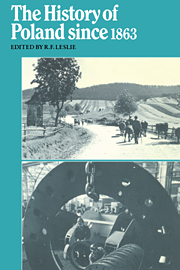Book contents
- Frontmatter
- Contents
- List of maps
- Preface to the paperback edition
- Abbreviations
- Map 1 Poland in the nineteenth century
- 1 Triloyalism and the national revival
- 2 Poland and the crisis of 1900–7
- 3 Poland on the eve of the First World War
- 4 The emergence of an independent Polish state
- 5 The breakdown of parliamentary government
- 6 Piłsudski in power, 1926–35
- 7 Poland without Piłsudski
- 8 Poland in defeat, September 1939–July 1941
- 9 The ill-fated alliance, August 1941–April 1943
- 10 The years of Tempest, May 1943–December 1944
- 11 Post-war Poland
- 12 The rise and ebb of stalinism
- 13 The October turning point
- 14 ‘The little stabilization’
- 15 The decline of Gomułka
- 16 Poland under Gierek
- 17 Polish society, 1945–75
- Epilogue: The rise and fall of Solidarity
- Notes
- Select bibliography
- Index
10 - The years of Tempest, May 1943–December 1944
Published online by Cambridge University Press: 26 December 2009
- Frontmatter
- Contents
- List of maps
- Preface to the paperback edition
- Abbreviations
- Map 1 Poland in the nineteenth century
- 1 Triloyalism and the national revival
- 2 Poland and the crisis of 1900–7
- 3 Poland on the eve of the First World War
- 4 The emergence of an independent Polish state
- 5 The breakdown of parliamentary government
- 6 Piłsudski in power, 1926–35
- 7 Poland without Piłsudski
- 8 Poland in defeat, September 1939–July 1941
- 9 The ill-fated alliance, August 1941–April 1943
- 10 The years of Tempest, May 1943–December 1944
- 11 Post-war Poland
- 12 The rise and ebb of stalinism
- 13 The October turning point
- 14 ‘The little stabilization’
- 15 The decline of Gomułka
- 16 Poland under Gierek
- 17 Polish society, 1945–75
- Epilogue: The rise and fall of Solidarity
- Notes
- Select bibliography
- Index
Summary
Changes in London and Warsaw
In 1943 the war entered a new phase. The Soviet forces held the last serious German offensive in the battle at Kursk on 12–15 July and themselves went over to the offensive, liberating large areas of the Soviet Union. North Africa was cleared of the Axis forces and for practical purposes fascist Italy was knocked out of the war by the Allied landings at Salerno in September 1943. In the Far East the American forces were to go over to the offensive and drive back the Japanese. It was no longer a question of whether the war would be won, but when it would be won. As the end approached, the situation of the Polish government-in-exile was difficult. Neither Britain nor the USA cared to look after its affairs in the USSR. In the end it was Australia who undertook to represent Polish interests. The London government continued to take its stand upon the frontiers of 1 September 1939, but Stalin expressed his view that a strong and independent Poland might be created at the end of the war. This gave Sikorski to hope that diplomatic relations might be resumed shortly. He continued to believe that the Western Allies would sooner or later bring the weight of their influence to bear upon the side of Poland. His tour of the Near and Middle East in June 1943 had the purpose of reassuring diplomatic representatives and military commanders and requesting them to preserve a stoic calm for the meantime.
- Type
- Chapter
- Information
- The History of Poland Since 1863 , pp. 246 - 279Publisher: Cambridge University PressPrint publication year: 1980



